Gubbins D., Herrero-Bervera E. Encyclopedia of Geomagnetism and Paleomagnetism
Подождите немного. Документ загружается.

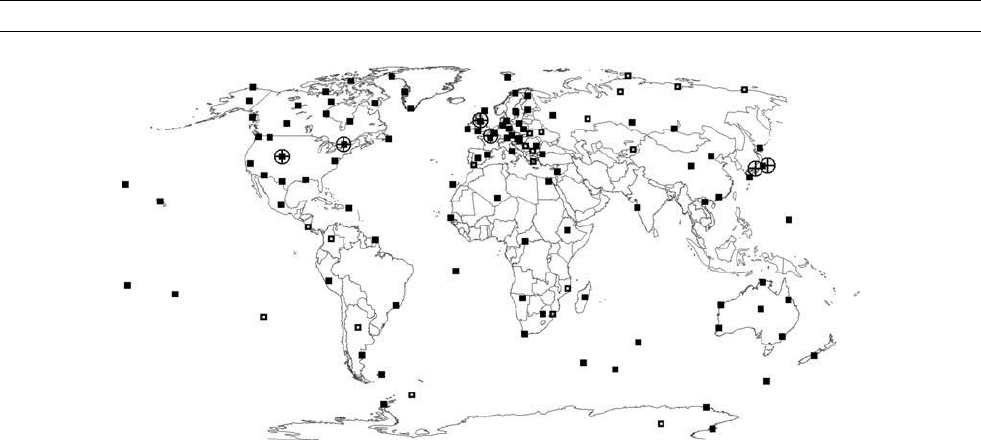
their data to the meteorological satellites GOES and METEOSAT.
Geomagnetic Information Nodes (GINs) in Golden, Ottawa, Hartland,
and Paris equipped with downlinks collected the data from the satellites
for archiving and distribution. The first transatlantic transmissions took
place in late 1988 and by early 1990, four USGS, two Canadian, three
French, and one British observatory were operating in INTERMAGNET
mode. The first CD-ROM with definitive data (see below) from 41 obser-
vatories in 11 countries was produced in 1991.
The network predictably evolved by increasing the amount of IMOs
and GINs, reaching 100 and 6, respectively, in 2005. The Geostation-
ary Meteorological Satellite (GMS) (Japan) was added in order to
cover the Asian continent. Where possible, data transfers by e-mail
from IMO to GIN replaced satellite transmission, for reasons of sim-
plicity and cost.
In 1997 a Web site was created at www.intermagnet.org
INTERMAGNET management
The Executive Council (EXCON totaling four members) establishes
policy for INTERMAGNET, deals with questions of international parti-
cipation and data exchange and communicates with national agencies
and international scientific and funding agencies. It is assisted and
advised by the 14 members of the Operations Committee (OPSCOM).
The OPSCOM advises the Executive Council on the technical issues
that arise within INTERMAGNET. This includes matters relating to
instrumentation, data processing, and communications. The committee
is also responsible for establishing and maintaining standards and for-
mats for the global exchange of data under the INTERMAGNET pro-
gram, for designing and publishing the INTERMAGNET Technical
Manual and producing the annual CD-ROM.
EXCON and OPSCOM meet about once a year for a few days in
order to manage the network and plan for the future.
The data
INTERMAGNET data consists of time series of the geomagnetic vec-
tor, sampled at the round minute and carefully filtered to avoid aliasing
effects. This data, collected at the IMOs represented on Figure O5 (full
squares), is continuously available from the GINs within 72 h. The
data come in different accuracies: reported (as recorded—near real-
time), adjusted (corrected for artificial spikes and jumps), and defini-
tive (reduced to baseline so that it has absolute accuracy). The latter
is made available a few months after the end of each year at the earliest
and surely with the production of the yearly CD-ROM.
People needing real-time will use the reported or adjusted data,
available from the GINs in daily ASCII files either in INTERMAG-
NET imfv1.22 or IAGA 2002 format (e-mail request or ftp).
Access to the recent definitive data is through the Web site. Older
data is available on the CD-ROMs. Definitive data come in monthly
files in binary code. Browsers are available for easy perusal and
inspection.
The data is freely available for bonafide scientific users. If any com-
mercial aspects are involved, the user should seek a financial arrange-
ment with the IMO directly.
All practical details about the data and for accessing them are avail-
able from the Web site where the Technical Manual is also available
for download.
The future
A large part of the activities of INTERMAGNET is devoted to
improve the global coverage of its network. Therefore future activities
will be oriented toward filling gaps in the network, mainly in the for-
mer Soviet Union, Latin America, and the oceans (see Figure O5).
Many oceanic island sites are still available for installing new IMOs
but lack of staff may impose fully automatic IMOs there (see Observa-
tories, automation). Open ocean sites are required to obtain the ulti-
mate global coverage (Rasson, 2001) and INTERMAGNET is keen
to support and advise groups contemplating the installation of ocean
bottom magnetic observatories.
Another development is the introduction of data sampling at 1 Hz,
which is in demand from the space weather community. In 2003,
INTERMAGNET defined an internal data file format (based on IAGA
2002 format) for interchange of this type of data. In the next years, it is
anticipated that 1 Hz data will progressively become the norm in IMOs
and that GINs will start disseminating and archiving them.
Jean L. Rasson
Bibliography
Green, A.W., Coles, R.L., Kerridge, D.J., and LeMouël J.-L., 1998.
INTERMAGNET, today and tomorrow. In Proceedings of the
VIIth Workshop on Geomagnetic Observatory Instruments, Data
Figure O5 INTERMAGNET magnetic observatories as full squares and Geomagnetic Information Nodes (GIN) as crossed circles
representing the global coverage in 2005. Open squares indicate some possible future IMOs.
716 OBSERVATORIES, INTERMAGNET

Acquisition and Processing ’96, Scientific Technical Report
STR98/21, GFZ-Potsdam, pp. 277–286.
Rasson, J.L., 2001. The status of world-wide network of magnetic
observatories, their location and instrumentation. Contributions to
Geophysics and Geodesy, 31: 427–453.
Cross-references
Geomagnetic Secular Variation
Harmonics, Spherical
IAGA, International Association of geomagnetism and Aeronomy
Internal External Field Separation
Main Field Maps
Main Field Modeling
Observatories, Automation
Observatories, Instrumentation
Observatories, Program in Australia
Time-Dependent Models of the Geomagnetic Field
OBSERVATORIES, PROGRAM IN AUSTRALIA
The first Australian magnetic observatory was “Rossbank” Observa-
tory at Hobart, established in 1840 by the British Association with sup-
port of the Royal Society during an expedition led by Captain James
Clark Ross in command of HMS Erebus and HMS Terror (Savours
and McConnell, 1982). Regular magnetic observations continued there
until the end of 1854. By the initiative of Dr. Georg Neumayer an
observatory was established by the Government of Victoria in
Melbourne in 1858 (Dooley, 1958), beginning one of the longest con-
tinuous series of magnetic observations in the world (Figure O6).
The original site of the Melbourne Observatory was in the Flagstaff
Gardens but it was moved in 1862 to the Botanical Gardens, the geo-
logically more suitable site originally chosen. Subsequent encroach-
ment of electric tramways and railways forced the move in 1919 to
Toolangi, where the observatory operated until 1986, at which time it
had been replaced by the Canberra Magnetic Observatory. The Carnegie
Institute of Washington’s Department of Terrestrial Magnetism
established Watheroo Magnetic Observatory in 1919 (McGregor,
1979), beginning the continuous recording of geomagnetic variations
on the western side of the continent. The Bureau of Mineral Resources,
Geology and Geophysics (BMR) was formed in 1946 (renamed the
Australian Geological Survey Organization in August 1992; then Geo-
science Australia (GA) in August 2001) soon after which both the mag-
netic observatories operating in Australia at that time were transferred to
its geophysical observatories program. A new magnetic observatory at
Gnangara replaced the Watheroo Observatory in 1958. The analogue vari-
ometer that operated at Watheroo was moved to Gnangara and operated
until mid-1990 when it was replaced with digital instrumentation. In
recent years there have been numerous burglaries and vandalism on the
site and there are plans to relocate to a less vulnerable site in the vicinity.
In the 1950s BMR established observatories in the Australian Antarctic
Territory (AAT) and sub-Antarctic islands. Macquarie Island Observatory,
established in 1952 is still in operation. Apart from the short-lived obser-
vatory at Cape Denison, Commonwealth Bay, the first permanent
observatory in AAT (which still operates) is at Mawson, established in
1955. The original instruments and buildings at Mawson came from
Heard Island Observatory. Observatories at Wilkes (established by the
USA IGY program), Port Moresby in Papua New Guinea, and Darwin
were completed in time for the 1957–1958 International Geophysical
Year (IGY). Wilkes Observatory was transferred to the Australian
Government after the IGY and operated by BMR until its closure in
1967. Observatory operations were are also maintained at Casey and Davis
in collaboration with the Australian Antarctic Division (McGregor, 2000).
Absolute control at Davis ceased in 2001. The observatory at
Port Moresby was established by BMR and operated from 1957 to
mid-1995. It was transferred to the Geological Survey of Papua New
Guinea in 1978. Absolute control ceased when the absolute magnet-
ometers were stolen in November 1993.
The observatory at Canberra was established in 1978 after the
Observatories Group of the BMR was transferred from Melbourne to
Canberra in the early 1970s. As Canberra was eventually to replace
Toolangi Observatory, and so contribute to a number of global geo-
magnetic indices, it was important to operate both observatories for
as long as possible to enable the K-indices from the observatories to
be statistically compared and station differences to be established.
Routine absolute observations at Toolangi ceased in 1979 although
the variometers continued and K-indices were scaled until early 1986.
Before Canberra Observatory was commissioned, all BMR’smag-
netic observatories made analogue recordings on photographic paper,
from which hourly mean values were scaled. Since its beginning in
1978 only digital instrumentation has operated at the Canberra Observa-
tory. All observatories commissioned subsequently were equipped to
digitally record variations in three orthogonal components as well as
the total field, initially at 1-min intervals, but presently at 1-sec intervals.
In 1983, the first of a new generation of digital observatories in
Australia was established at Charters Towers. The variometers are
installed deep within a disused mine tunnel in the side of a hill on
the site of the Seismograph Station. The Learmonth Magnetic Obser-
vatory was installed on the site of the Learmonth Solar Observatory
(operated jointly by the Australian Ionospheric Prediction Service
and the US Air Force) in late 1986. Small concrete vaults in the
ground house the variometer and proton magnetometer sensors. In
mid-1992 an observatory was established at Alice Springs on a com-
pound of the CSIRO Arid Zone research. It remains the only Austra-
lian observatory further than 120 km from the sea and so free from
oceanic induction effects. The variometers are housed in concrete
vaults similar to those at Learmonth.
The most recently established observatory is that at Kakadu in the
Northern Territory, located on the South Alligator Ranger Station of
the Australian Nature Conservation Agency, where recording began
in March 1995. Problems with lightning strikes have plagued the
observatory, resulting in a number of long breaks in data acquisition
and instrumentation changes.
All Australian observatories now have 1-sec digital computer-based
data acquisition with data available in near real-time via either dial-up
or network connections.
The main basis of the 5-yearly regional field models is the large col-
lection of ground, airborne, marine, and satellite survey data. Observa-
tory data, supplemented by repeat station data provide the main basis
for the secular change part of the models. Together with the ongoing
repeat station surveys comprising 15 super repeat stations that cover
Australia, South-West Pacific Islands, and Papua New Guinea, it has
been estimated that, together with the New Zealand and Indonesian
observatories, GA’s Geomagnetism program monitor variations of
the Earth’s magnetic field over approximately an eighth of the Earth’s
surface. Figure O7 shows the current Australian Observatory network
and super repeat stations.
Calibration of observatory variometers is achieved by regular absolute
observations with magnetometers that have been extensively intercom-
pared. Final observatory data are thus consistent across the continent.
Past calibrations of quartz horizontal magnetometers (QHMs) at the
Danish Meteorological Institute and recent intercomparisons at IAGA
Geomagnetism Workshops have ensured Australian absolute magneto-
meters are kept to international standards. Since the 1980s, classical
absolute magnetometers have gradually been replaced by the declination
and inclination magnetometer (DIM) together with the proton precession
magnetometer (PPM) as the principal means of calibrating the observatory
variometers. The accuracy of data produced by the Australian observatories
has been enhanced by the availability of a magnetometer calibration
facility at the Canberra Magnetic Observatory, in operation since
2000, providing highly accurate scale-values, relative sensor orien-
tations, and temperature sensitivities of three-component observatory
OBSERVATORIES, PROGRAM IN AUSTRALIA 717
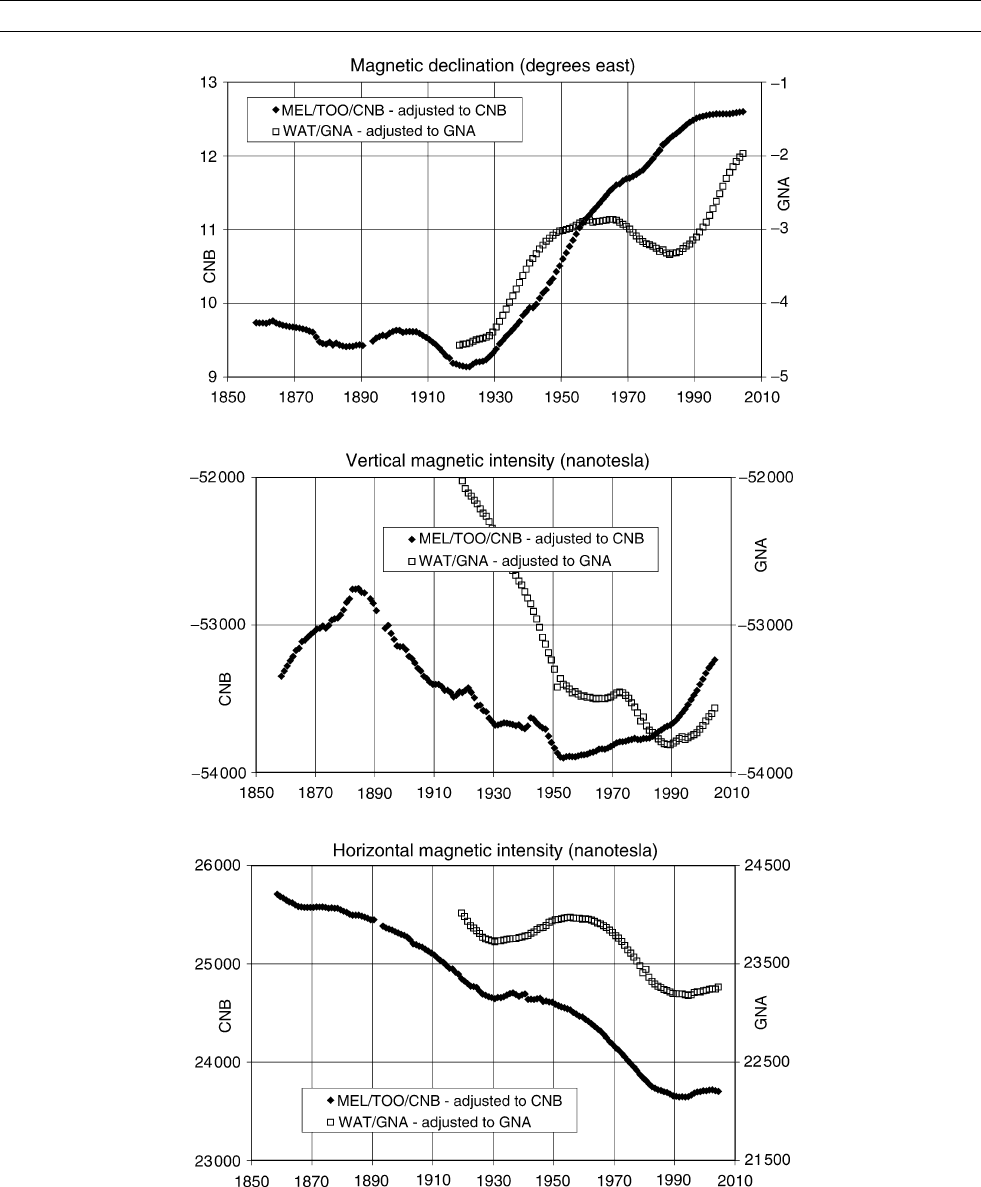
variometers. These parameters were previously derived from sequences of
absolute observations through baselines.
Although the emphasis of GA’s program in geomagnetism is toward
solid-earth geophysics, with a time resolution of 1 s and observational
accuracy of the order of tenths of a nanotesla, information of relevance
to upper-atmospheric, magnetospheric, and solar physics is available.
One-minute vector data and hourly mean values are regularly provided
to the world data centers in Boulder, USA and Copenhagen, Denmark.
Data from most observatories are also transmitted by e-mail daily or
more frequently to the Edinburgh GIN of the INTERMAGNET project.
Figure O6 Annual mean values in magnetic declination, vertical intensity, and horizontal intensity from the succession of observatories
at Melbourne, Toolangi, and Canberra adjusted to Canberra; and Watheroo and Gnangara adjusted to Gnangara.
718 OBSERVATORIES, PROGRAM IN AUSTRALIA
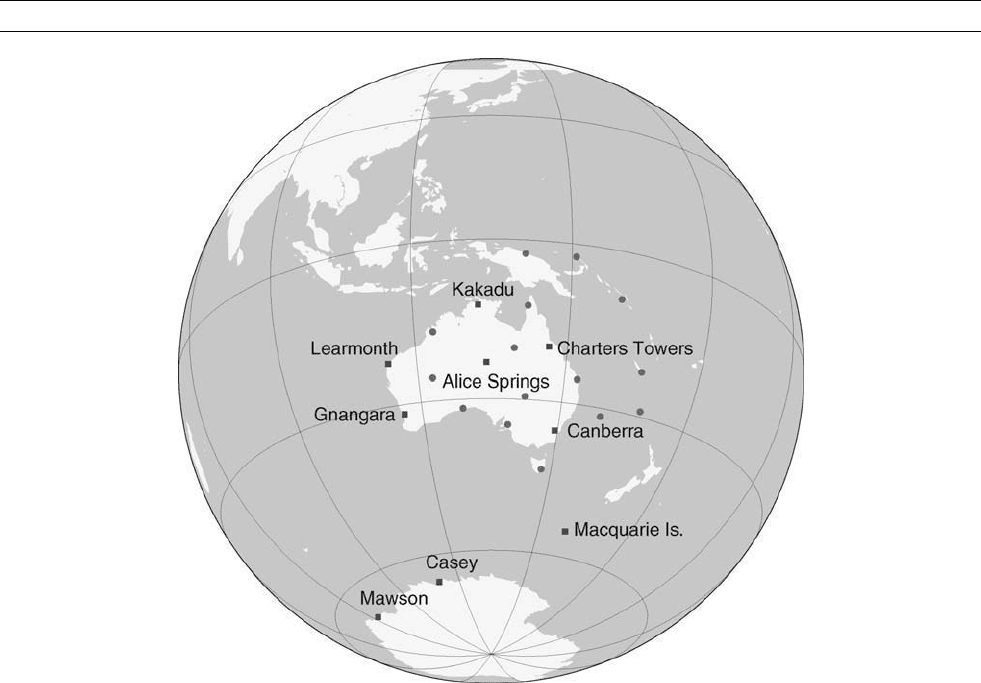
K -indices are is scaled from magnetogram records from the
Canberra, Gnangara, and Mawson observator ies, applying the classical
method of hand-scaling until late 2002. As this index is still in
demand, and as no computer algorithms has quite been able to emulate
the results of manual scaling, a comput er-assisted method of manual
scaling has been developed at GA. Using the LRNS (Hattingh et al.
1989) algorithm to produce an estimate of the undisturbed daily (reg-
ular solar or SR) variation that overlays the daily magnetogram on a
computer screen, the SR curve is manipulated on the screen into a
form that would be applied if scaling manually. Australian observa-
tories contribute toward the global Kp-index and its derivatives, the
aa-index and the am-index.
GA maintains a corporate database that has been gradually populated
with data and information from all projects undertaken by the organiza-
tion. There is a long history of geomagnetic operations at GA as well as
holdings of data acquired before the organization existed. Software has
been developed that enables geomagnetic data to be loaded into the cor-
porate database as soon as it is transmitted to headquarters. This,
together with the steady population with historical data, has allowed
access to Australian geomagnetic data via the Internet.
Detailed descriptions of the observatories, their operations, histories,
and data summaries can be found in the Australian Geomagnetism
Report series, especially from 1993 when the contents of the report
was expanded beyond monthly summaries. The more recent issues
are available on the GA Web site: http://www.ga.gov.au
Peter A. Hopgood
Bibliography
Dooley, J.C., 1958. Centenary of Melbourne-Toolangi magnetic
observatory. Journal of Geophysical Research, 63: 731–735.
Hattingh, M., Loubser, L., and Nagtegaal, D., 1989. Computer K-index
estimation by a new linear-phase, robust, non-linear smoothing
method. Geophysical Journal International, 99:533–547.
Hopgood, P.A., 1993–2003. Australian Geomagnetism Report (series).
AGSO & GA.
McGregor, P. M., 1979. Australian magnetic observatories. BMR Jour-
nal of Australian Geology and Geophysics, 4: 361–371.
McGregor, P.M., 2000. Observatory geophysics, 1947–1998. Aurora
(ANARE Club Journal), 19(3): 3–21.
Savours, A., and McConnell, A., 1982. The history of the Rossbank
observatory, Tasmania. Annals of Science, 39: 527–564.
Cross-references
Coast Effect of Induced Currents
Department of T errestrial Magnetism, Carnegie Institution of W ashington
Geomagnetic Secular Variation
History of Geomagnetism
Intermagnet Observations
Magnetic Indices (contents entry only)
Main Field Modelling
Observatories in Antarctica
Repeat Stations
Figure O7 Locations of magnetic observatories (named squares) and super repeat stations (round dots) operated by Geoscience
Australia in 2005.
OBSERVATORIES, PROGRAM IN AUSTRALIA 719

OBSERVATORIES, PROGRAM IN THE
BRITISH ISLES
History
In his survey of magnetic observatories that have operated in the British
Isles, Robinson (1982) lists 18 locations, including 11 in England, 4 in
Scotland, 2 in the Republic of Ireland, and 1 on the island of Jersey. The
earliest two observatories were both constructed in 1838: in the grounds
of Trinity College, Dublin; and in Greenwich Park, London, where an
astronomical observatory had been established following a warrant
issued by King Charles II in 1675. The earliest known measurement
of magnetic declination at Greenwich is that made by John Flamsteed
in 1680, and declination measurements were made there regularly from
1816, to assist in the calibration of ships’ compasses. The initial pro-
gram of observations at Dublin and Greenwich consisted of two-hourly
measurements. Both observatories, along with that at Makerstoun in
Scotland, participated in the Göttingen Magnetic Union (1836–1841),
which promoted simultaneous measurements at cooperating observa-
tories, and certain days were designated “term days” when observations
were made every 5 min. A British artillery officer, Edward Sabine, was
a chief protagonist of the efforts by the Göttingen Magnetic Union to
establish a global network of observatories, and through this, several
observatories were set up by the British in its colonies at the time (see
Gauss, Carl Friedrich; Humbolt, Alexander von; Sabine, Edward;and
Geomagnetism, history of ).
The laborious nature of meteorological and magnetic observations
stimulated a drive to develop automatic recording devices, and Charles
Brooke designed the photographic magnetographs that were brought
into operation in Greenwich in 1847 (Brooke, 1847). Francis Ronalds,
working at Kew Observatory, which had been built at Richmond, London,
for King George III to observe the transit of Venus in 1769, also produced
a photographic magnetograph at around the same time as Brooke’s.
Ronalds’ instrument was later redesigned by John Welsh to produce the
Kew-pattern magnetograph that was subsequently installed in many
observatories around the world (Stewart, 1859). The instrumental devel-
opments by Brooke and Ronalds established the standard technique
employed for magnetic observatory recording worldwide for more than
a century (see Instrumentation, history of ).
Observations at Dublin Observatory were short-lived, continuing only
until 1850. A meteorological observatory was established on Valentia
Island, Kerry , in 1867 and regular absolute magnetic observations com-
menced there in 1888. The observatory was moved to the mainland,
close to the town of Cahirciveen, in 1892, but kept the name Valentia
Observatory. Continuous recording instruments were first installed
in 1953. Met Éireann, the Irish meteorological service, now runs the
observatory.
Geomagnetic measurements in London were to become impossible
because of electrification of the railway and tramway systems. Kew
Observatory suffered disturbances from about 1900 and with compen-
sation from the tramway company responsible, Eskdalemuir Observa-
tory, in the Southern Uplands of Scotland, was built. Eskdalemuir was
selected as one of very few places in Great Britain that was more than
10 miles from the then extensive rail network. Construction work at
Eskdalemuir started in 1904 and a full program of magnetic observations
began in 1908. Later, the geomagnetic work carried out at Greenwich was
similarly affected and was transferred to Abinger Observatory, on Leith
Hill, London, in 1924. Observations were made there until April 1957
when, once more, disturbances from electrified railways reached intoler-
able levels. A transfer of operations was planned and a magnetic observa-
tory was constructed close to the village of Hartland, Devon. Hartland
Observatory opened in 1957, in time for the observatory to participate in
the International Geophysical Year (IGY). Overlapping measurements
were made at the times of the Greenwich-Abinger and the Abinger-
Hartland moves, establishing site differences and enabling the records
from the three observatories to be combined.
Lerwick Observatory in the Shetland Isles was established as a
meteorological station in 1919 and geomagnetic measurements began
there in 1922. Lerwick, Eskdalemuir, and Hartland are the three mag-
netic observatories in operation in the UK in 2005. They are run by the
British Geological Survey (BGS), a component body of the Natural
Environment Research Council. Lerwick and Eskdalemuir continue
to have roles as meteorological stations, and seismological equipment
is operated at all the observatories.
Observatory operations in 2005
The main objective of a magnetic observatory is to record geomagnetic
field variations continuously, over the long term, at a stable location,
and to maintain the accuracy required to produce data of the quality
needed for studies of the slow changes of the main geomagnetic field
generated in the Earth’s core, the secular variation. The combination of
magnetographs, based on suspended magnet instruments and photo-
graphic recording, supported by regular absolute observations, enabled
the UK observatories to achieve this objective over many decades.
However, the observatory operations were labor-intensive, both in run-
ning the magnetographs and in processing the analog photographic
recordings. By the 1970s, technical developments in fluxgate and pro-
ton precession magnetometers gave an alternative set of observatory
instruments, and advances in digital data acquisition and computing
presented new opportunities for observatory automation. The BGS
began a development program, and automatic digital systems were
adopted as the observatory standard recording equipment at the three
UK observatories on January 1, 1983 (see Geomagnetic secular varia-
tion; Observatories, instrumentation).
Since 1983, technology has continued to develop, bringing significant
improvements to magnetometer performance and data acquisition and
communications. The latest generation systems used at the UK observa-
tories were commissioned on January 1, 2003, again based on the com-
bination of fluxgate and proton precession magnetometers. The fluxgate
magnetometer output is sampled once per second and the data are trans-
mitted to the BGS offices in Edinburgh within minutes. A fluxgate-
theodolite combination is used to make regular (manual) absolute
measurements of magnetic declination and inclination, with the proton
magnetometer providing absolute values of total field strength.
Instruments similar to those at the UK observatories are used at
Valentia Observatory. Efforts to improve the global coverage of obser-
vatories continue and to this end observatories were set up by the BGS
on Ascension Island and at Port Stanley in the Falklands Islands in
1992 and 1994, respectively.
Uses of the observatory data
In 2005, the combination of data from magnetic survey satellites, such
as Ørsted and CHAMP, and observatories worldwide, is providing a
rich resource for research into core processes. The data also bring prac-
tical benefits through their use in the production of global and national
magnetic field models and charts used for navigation. Here, observa-
tory data are of great importance because of the information they give
on the secular variation, providing the basis for estimation of future
values of the geomagnetic field at a given location (see Ørsted;
CHAMP; Main field maps; Main field modeling; and IGRF, Interna-
tional Geomagnetic Reference Field).
Observatories also provide data on the relatively rapidly varying
magnetic fields of ionospheric and magnetospheric origin. These “dis-
turbance fields,” indicative of “space weather” conditions, are charac-
terized by various geomagnetic activity indices (Mayaud, 1980). Each
of the UK observatories has provided data for the computation of the
Kp-index since its creation in 1932. Data from the Greenwich-Abinger-
Hartland series, together with data from Australian observatories, have
been used to construct the aa-index, which extends from 1868, providing
valuable information on long-term changes in solar-terrestrial interactions.
(Both the Kp- and the aa-indices are computed for 3-h intervals.) When
720 OBSERVATORIES, PROGRAM IN THE BRITISH ISLES

space weather conditions are such that a major geomagnetic disturbance, a
magnetic storm, is in progress, operations in space and on the ground can
be at risk. Global geomagnetic activity indices, such as Kp, are used
widely as measures of disturbance. Satellite management, assessment of
propagation conditions for radio and GPS signals, and geophysical sur-
veying are examples of applications where indices are used (see Storms
and substorms, magnetic an d Geomagnetic hazards).
By collecting 1-s samples, the UK observatories are producing data
useful for research into external magnetic fields. Data at this time reso-
lution are required for, and are applied to, modeling geomagnetically
induced currents, which is of interest to the electricity distribution indus-
try. A further modern-day application, important to hydrocarbons pro-
duction around the UK, is the use of accurate magnetic reference data
t o c orr ec t w el lb ore s ur ve y m ea su re me n t s a cq ui re d u si ng m a gn et ic s ur-
vey tools. Data from the UK magnetic observatories are used in the ana-
lysis of data collected in measurement-while-drilling operations, and this
application demands the rapid access to the data that the UK observa-
tory operations provide. This application has resulted in observatories
being set up on Sable Island, offshore Nova Scotia, and at Prudhoe
Bay in northern Alaska by Halliburton with the assistance of the BGS.
Outloo k
Lerwick, Eskdalemuir, Hartland, Valentia, Ascension, and Port Stanley
are all INTERMAGNET observatories and hence are members of a
coordinated global monitoring network operating to high modern stan-
dards (see Observatories, INTERMAGNET ). This echoes the participa-
tion of observatories in the British Isles and Empire in the Göttingen
Magnetic Union. These observatories are providing data for scientific
research, for global data products, and are also finding local applica-
tions for the data they produce. The scientific and “real world ”
demands for the data are as strong today as at any time in the past.
David Kerridge
Bibliogr aph y
Brooke, C., 1847. Description of apparatus for automatic registration
of magnetometers and other meteorological instruments by photo-
graphy. Philosophical Transactions of the Royal Society of London,
137:69– 77.
Mayaud, P.N., 1980. Derivation, Meaning and Use of Geomagnetic
Indices. American Geophysical Union, Geophysical Monograph 22.
Washington, DC: American Geophysical Union.
Robinson, P.R., 1982. Geomagnetic observatories in the British Isles.
Vistas in Astronomy, 26 : 347– 367.
Stewart, B., 1859. An account of the construction of the self-recording
magnetographs at present in operation at the Kew Observatory.
British Association Report 1859 , pp. 200– 228.
Cross- refere nces
CHAMP
Gauss, Carl Friedrich (1777 –1855)
Geomagnetic Hazards
Geomagnetic Secular Variation
Geomagnetism, History of
Humbolt, Alexander von (1759 – 1859)
IGRF, Interna tional Geomagnetic Reference Field
Instrumentation, History of
Magnetometers, Laboratory
Main Field Maps
Main Field Modeling
Observatories, Instrumentation
Observatories, INTERMAGNET
Ørsted
Sabine, Edward (1788–1883)
Storms and Substorms, Magnetic
OBSERVATORY PROGRAM IN FRANCE
The French contribution to the history of measuring the Earth ’ s mag-
netic field is a long one, which began at least as early as the 16th cen-
tury, with the first declination measurement performed by Künstler
Bellarmatus in 1541. In 1667, the Académie des Sciences decided to
build an observatory in Paris and take declination measurements.
Before beginning construction, an initial measurement was made on
June 21, 1667 using a 5-in. needle. Subsequent measurements were
performed from 1667 onward, sometimes continued as a family tradi-
tion (La Hire, Cassini, Maraldi). There are fewer measurements of
inclination than declination at the Paris Observatory, owing mainly
to its late discovery; but also, it was of less interest to navigators,
and presented a greater problem for accurate measurements. More
details about the observations of declination and inclination in the
Paris region are given in Alexandrescu et al. (1996).
The study of geomagnetism in France has benefited from the centra-
lized nature of the French governments through the last centuries,
as only a few site changes are to be noted, and a long continuous
measurement series is now available. Indeed, the Paris series for
declination and inclination span more than four and three centuries,
respectively. The available annual means of declination (1541– 2004)
and inclination (1671 – 2004), adjusted to the Chambon la Forêt
Observatory are presented in Figure O8.
Chambon la Forêt —the French National Magnetic Observatory.
The year 1883 marks the creation of the French National Magnetic
Observatory. This was installed successively at Parc Saint-Maur
(1883 – 1901), Val-Joyeux (1901 – 1936), and Chambon-la-Forêt (1936
to present day), as a consequence of the encroachment of urbanization
in the Paris area and of the resulting electromagnetic pollution. From
the beginning of the 1980s, absolute measurements have been made
using the same fluxgate theodolite and consistent procedures. Three
field components are recorded continuously by three different fluxgate
variometer systems, and the total field is measured by two Overhauser
proton magnetometers. From these continuous time series, 1-min
values are produced. Longer series, for example, hourly means (since
1936) or monthly means (since 1883) are also available.
Bureau Central de Magnétisme Terrestre (in 2004). The Institut de
Physique du Globe de Paris (IPGP)
1
, the Ecole et Observatoire des
Sciences de la Terre de Strasbourg (EOST)
2
, and the Institut de
Recherche pour le Développement de Bondy (IRD, ex-ORSTOM)
3
are responsible for the magnetic observatories located in French terri-
tories or maintained in cooperation with local institutes in foreign
countries. The IPGP, EOST, and IRD consolidate their activities in a
“ Bureau Central de Magnétisme Terrestre” (BCMT),
4
and they contri-
bute to running 16 observatories in total (Table O1 ). Many of these are
in the Southern Hemisphere or in regions of the world with few other
observatories.
Some of the main tasks of the BCMT are (1) gathering the observa-
tory data and publishing them according to the IAGA/INTERMAG-
NET recommendations; (2) controlling installation and function of
magnetic observatory equipments; (3) specifying procedures for data
acquisition and processing; (4) disseminating observatory data and
results by year-books and CDs; (5) maintaining continuous coopera-
tion programs with international associations and local institutes in
the various countries where the observatories are located.
Cooperation programs. Cooperation programs between BCMT and
different institutes have been established, mainly to run observatories
in remote areas where local support is lacking (Algeria, Central Afri-
can Republic, China, Ethiopia, Lebanon, Madagascar, Russia, Senegal,
Vietnam). All French observatories or those run in cooperation have
1
http://w ww.ipgp.juss ieu.fr/
2
http://eo st.u-strasbg.fr/
3
http://w ww.ird.fr/
4
http://obsm ag.ipgp.jussieu .fr/
OBSERVATORY PROGRAM IN FRANCE 721
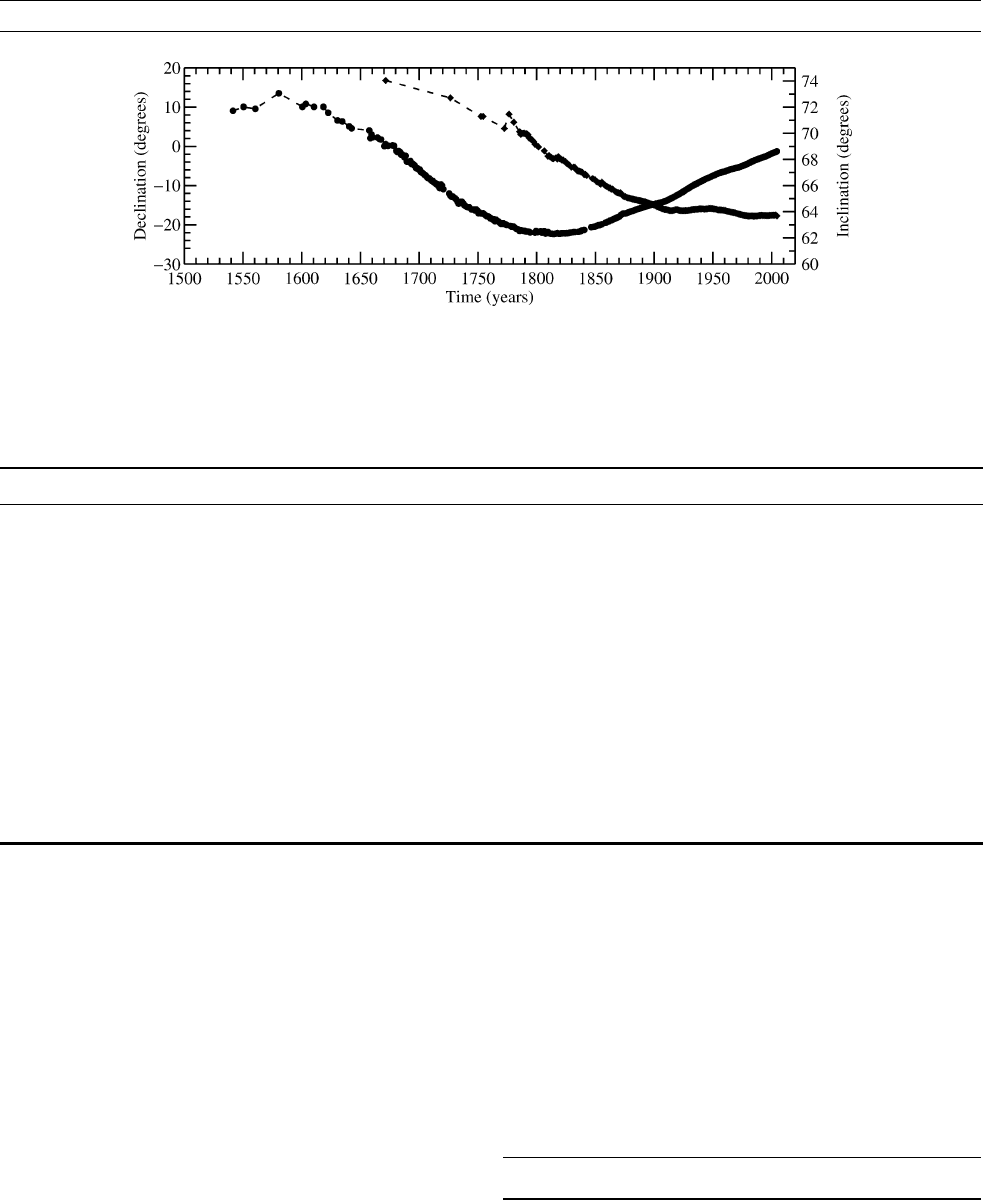
full absolute control, providing 1-min magnetic field values measured
by a vector magnetometer, and an optional scalar magnetometer, all
with a resolution of 0.1 nT (see Observatories, instrumentation). More
details about the instruments used through time are given in Bitterly
et al. (1999).
All of these observatories are operated according to the principles
and conditions necessary and desirable for maintaining a service
of rapid magnetic observatory data exchange. The daily data quality
control, the weekly absolute measurements, and the definitive data
processing are done according to INTERMAGNET standards (see
Observatories, INTERMAGNET). The observatory data are used for
many specific uses, from characterizing the magnetic activity to
modeling magnetic field contributions (see Observatories, overview).
Mioara Mandea
Bibliography
Alexandrescu, M., Courtillot, V., and Le Mouël, J.-L., 1996. Geomag-
netic field direction in Paris since the mid-XVIth century. Physics
of the Earth and Planetary Interiors, 98: 321–360.
Bitterly, J., Mandea Alexandrescu, M., Schott, J.-J., and Vassal, J.,
1999. Contribution de la France à l’observation cu champ
magnétique terrestre. In B Comité National Français de Géodésie
et Géophysique, Rapport Quadriennal 1995–1998. Toulouse,
pp. 145–158.
Cross-references
Observatories, Instrumentation
Observatories, INTERMAGNET
Observatories, Overview
OBSERVATORIES, PROGRAM IN USA
The Geomagnetism Program of the US Geological Survey has, for
over a century now, monitored the Earth’s magnetic field through a
network of magnetic observatories and conducted scientific analysis
on the data collected. The program traces its origins to the Reorganiza-
tion Act of 1843, in which Congress authorized the creation of a
coastal survey agency, as part of the Treasury Department, that was
responsible for, among other things, geomagnetic surveys. The 19th
century saw the establishment of relatively short-lived magnetic sta-
tions, as well as the production of declination maps for the United
Figure O8 Annual means of declination (full circles, left axis) and inclination (full diamonds, right axis) adjusted to the Chambon la
Fore
ˆ
t Observatory.
Table O1 Observatories operating with assistance from BCMT, in 2004
Code Name Latitude (
) Longitude (
) Altitude (m) Start-date
AAE Addis Ababa 9.030 38.765 2442 1958
AMS Martin de Vivies 37.833 77.567 48 1981
BNG Bangui 4.437 18.565 395 1952
BOX Borok 58.030 38.972 137 1977
CLF Chambon la Foret 48.024 2.260 145 1936
CZT Port Alfred 46.433 51.867 155 1974
DRV Dumont Durville 66.665 140.007 30 1957
KOU Kourou 5.100 307.400 10 1996
LZH Lanzhou 36.083 103.850 1560 1959
MBO Mbour 14.392 343.042 10 1952
PAF Port Aux Francais 49.350 70.220 15 1957
PHU Phutuy 21.033 105.967 5 1978
PPT Papeete 17.550 210.380 342 1968
QSB Qsaybeh 35.645 33.870 525 2000
TAM Tamanrasset 22.800 5.530 1395 1932
TAN Antananarivo 18.920 47.550 1375 1890
722 OBSERVATORIES, PROGRAM IN USA
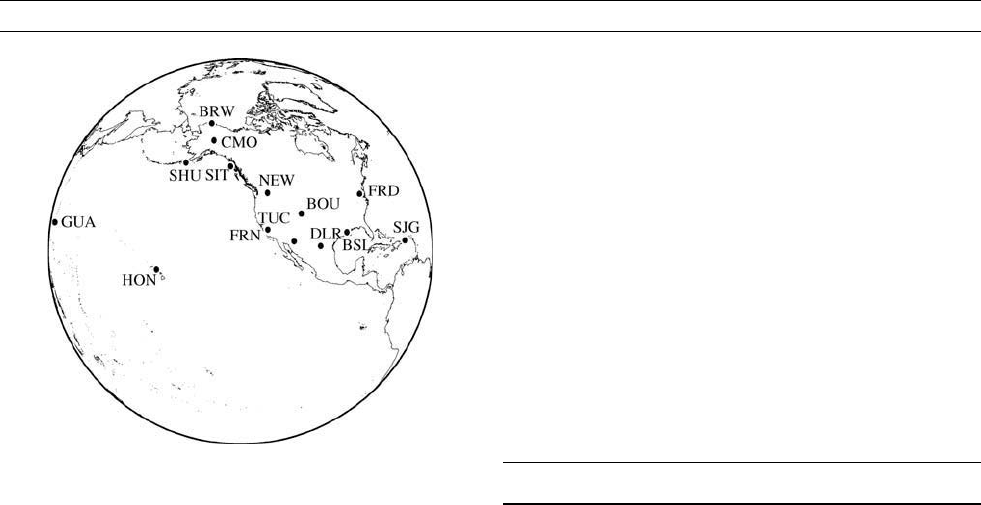
States and territories. With the purchase of Alaska, coastal surveys
became an increasingly higher priority, and in 1889 the Coast and Geo-
detic Survey, with a Division of Terrestrial Magnetism, was established.
The first essentially permanent geomagnetic observatories were estab-
lished under the Division’s leadership of Dr. Louis A. Bauer and Dr.
John A. Fleming: Cheltenham Maryland Observatory was established
in 1900, subsequently moved to the Fredericksburg site in 1956; Sitka
Alaska Observatory was established in 1901 and that of Honolulu
Hawaii in 1902. Soon after these observatories became operational, it
was found that the Sitka and Honolulu magnetometers were also sensi-
tive to local earthquakes, and so seismometers were installed at the sites.
In part, because of this colocation of instruments, the magnetic and seis-
mological programs in the Coast and Geodetic Survey were united in
1925 under the Division of Geomagnetism and Seismology. Over the
years, the Geomagnetism Program has evolved in response to the needs
of the United States and in response to changes in the nation’s various fed-
eral agencies. In 1903 the Coast and Geodetic Survey was transferred to
the newly organized Department of Commerce, and in 1970 the survey
became part of the National Oceanic and Atmospheric Administration
(NOAA). In 1973, the US Geological Survey of the Department of
the Interior assumed responsibility for the nation’sGeomagnetismand
Seismology programs.
Today, Geomagnetism is one of four programs, in addition to the
National Earthquake Hazards, the Global Seismic Network, and the
Landslides Programs, represented by the USGS Central Region Geo-
hazards Team in Golden, Colorado. Unlike the Earthquake Hazards
Program, which supports many different projects, based primarily in
Menlo Park and in Golden, the National Geomagnetism Program is a
self-contained entity within the USGS and the team. A major part of the
program is concerned with operating and maintaining magnetic observa-
tories located in the United States and its territories (see Figure O9). The
observatories, which have modern digital acquisition systems, are
designed to produce long time series of stable magnetometer data having
high accuracy and resolution. The observatory data are collected, trans-
ported, and can be disseminated in near-real time. The program has made
a considerable investmentin computing technologyto enable efficientpro-
cessing and management of data. By necessity, the network, and every-
thing associated with handling the data, is technologically elaborate; it
consists of many finely tuned components, each of which need to be oper-
ated in careful synchronization. The USGS observatories form an impor-
tant part of the INTERMAGNET network, within which the USGS
has an important leadership role. The USGS Geomagnetism Program,
working in cooperation with other Federal Government departments
and bureaus, most particularly the NOAAs Space Environment Center
and the US Air Force Weather Agency, is an integral part of the
Federal Government’s National Space Weather Program. Further details
about the USGS Geomagnetism Program are available at http://geomag.
usgs.gov
Jeffrey J. Love and J.B. Townshend
Cross-references
Bauer, Louis Agricola (1865–1932)
Fleming, John Adam (1877–1956)
IGRF, International Geomagnetic Reference Field
Observatories, Automation
Observatories, INTERMAGNET
Observatories, Overview
OBSERVATORIES IN ANTARCTICA
Some historical landmarks
The history of magnetic measurements in Antarctica and the surround-
ing oceans can be traced back to the expeditions looking for the South
Magnetic Pole (see Fogg, 1992 for a review). Until the turn of the 19th/
20th century, all measurements were performed at sea, on ships includ-
ing Gauss (E. Drygalski expedition, 1901–1903) and Discovery (first
R.F. Scott expedition, 1901–1904), both being equipped with a magnetic
observatory (Lüdecke, 2003). The first confirmed landing (although cer-
tainly not really the first one), can be credited to C. Borchgrevink’s expe-
dition (1893–1895), whose party reached Cape Adare and made some
magnetic measurements there (Fogg, 1992). If we define the Antarctic
region as that being south of 60
S the longest span of data is that collected
at the observatory of Orcadas del Sur (South Orkneys, IAGA code ORC).
This observatory was founded by R.C. Mossman in 1903 during the expe-
dition led by W.S. Bruce, 1902–1904, (Moneta, 1951). Many annual
means of the magnetic elements are available from this observatory from
1905 up to now. Other early observatories had a rather short or intermittent
life, for example, Hut Point (Discovery Bay) set up by the first R.F. Scott
expedition (1902–1903), Cape Evans (1911–1912) opened during the tra-
gic second expedition headed by R.F. Scott, Cape Denison (1912–1913)
opened by D. Mawson, and Little America (ran intermittently at various
locations from 1929 to 1958). Things changed after World War II. It
seems that P.N. Mayaud pioneered this new era with the observatory of
Port Martin built in 1951 (Mayaud, 1953). Unfortunately, the station
burned down 2 years later. Neither the first International Polar Year
(1882–1883), which came too early for Antarctica, nor the second IPY
(1932–1933) that was launched during an economically depressed time
gave to scientific activities in Antarctica. However, the first gave Geophy-
sical Year (1957–1958) boosted the opening of several observatories
increasing the total number from around 4 to 14. All of the observatories
recorded field variations on analog photographic magnetograms accord-
ing to common practice in use before the advent of digital records in
the 1970s. The first reported digital records were performed at Dumont
d’Urville in 1969.
Situation at the beginning of the 21st century
At present, more or less permanent sites may be divided into three
types: standard observatories with or without regular absolute mea-
surements, unmanned magnetometer chains devoted to external field
studies, and repeat stations, the latter two being beyond the scope of
this review. According to J.L. Rasson (2001), there are a total of
44 observatories in the region with data for various time spans.
Figure O9 The geographic distribution of USGS geomagnetic
observatories, identified by their three-letter IAGA codes.
OBSERVATORIES IN ANTARCTICA 723
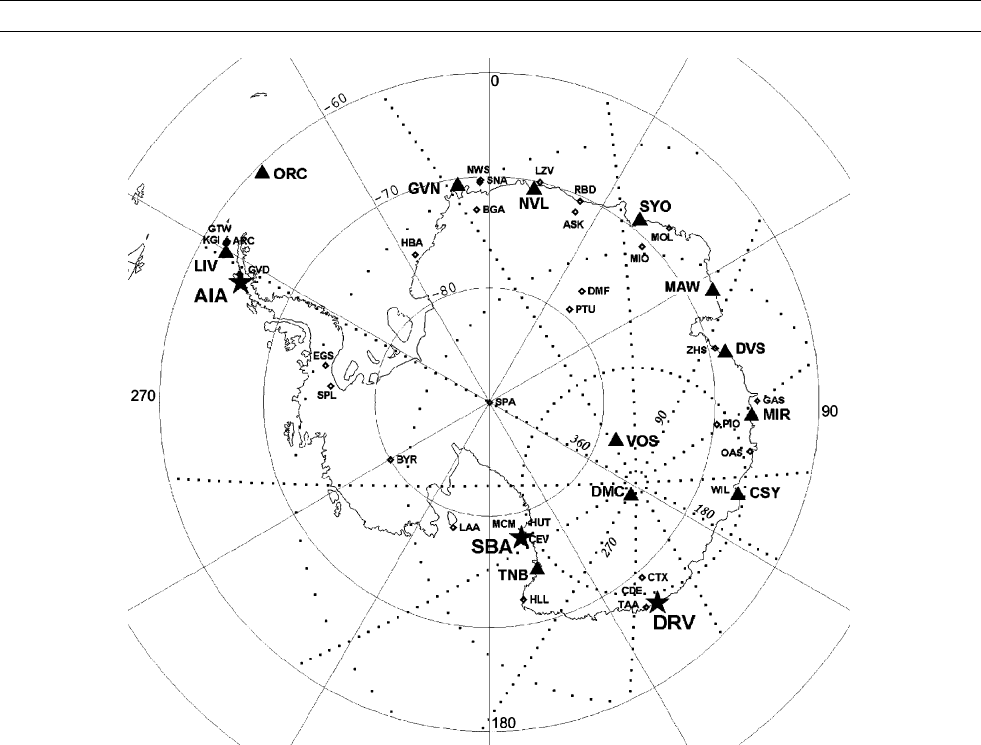
Figure O10 displays the locations of all known observatories with
respect to both geographic and geomagnetic coordinates. It shows that
only a handful of the observatories were located on the ice cap. Vostok
is the only survival of this on-land group, not taking into account
the new base currently opening at DomeC (French-Italian Concordia
station, DMC). ORC is the only observatory, opened before the first
IPY that continues its activity today. The time spans of the observa-
tories set up around the first IPY are highly variable, ranging from
1 year to nearly the full interval 1957–2004. In 2005, there are around
a dozen observatories still running. To be termed as observatories it is
necessary that they yield relative records complemented by baseline
control afforded by absolute measurements. The quality of this control
is variable. It ranges from episodical measurements performed during
summer campaigns to measurements made regularly throughout the
year at the staffed bases hosting qualified observers. There are cur-
rently three INTERMAGNET observatories (AIA, DRV, and SBA) in
the region (see Observatories, INTERMAGNET).
The history of magnetic observatories in Antarctica closely reflects
the history of the exploration of this mysterious and barely accessible
continent. Their data are particularly useful for southern auroral and
polar cap studies as well as tracking changes in the main field in this
large region.
Acknowledgments
Updated information were provided by A. Kadokura (NIPR, Japan),
V.O. Papitashvili (University of Michigan, Ann Arbor), P. Crosthwaite
(Geoscience Australia), and A. Eckstaller (Alfred Wegener Institute,
Bremen, Germany).
Jean-Jacques Schott and Jean L. Rasson
Bibliography
Fogg, G.E., 1992. A history of Antarctic Science. New York: Cam-
bridge University Press.
Lüdecke, C., 2003. Scientific collaboration in Antarctica (1901–04): a
challenge in times of political rivalry. Polar Record, 39:35–48.
Mayaud, P.N., 1953. Champ magnétique moyen et variation séculaire en
Terre Adélie au 1er janvier 1952. Comptes Rendies Académic des
Sciences Paris, 256:954–956.
Moneta, J.M., 1951. Cuatro Años en las Orcadas del Sur. Peuser: Bue-
nos Aires.
Rasson, J.L., 2001. The status of the world-wide network of magnetic
observatories, their location and instrumentation. Proceedings IXth
IAGA Workshop, 2000, Contributions to Geophysics and Geodesy,
31: 427–454.
Cross-references
Geomagnetism, History of
IAGA, International Association of Geomagnetism and Aeronomy
Magnetometers
Observatories, INTERMAGNET
Observatories, Overview
Figure O10 Location of the magnetic observatories in Antarctica. Large full triangles: open; stars: INTERMAGNET observatories; small
open squares: closed. Dotted lines: geomagnetic coordinates according to the 2005 IGRF model.
724 OBSERVATORIES IN ANTARCTICA
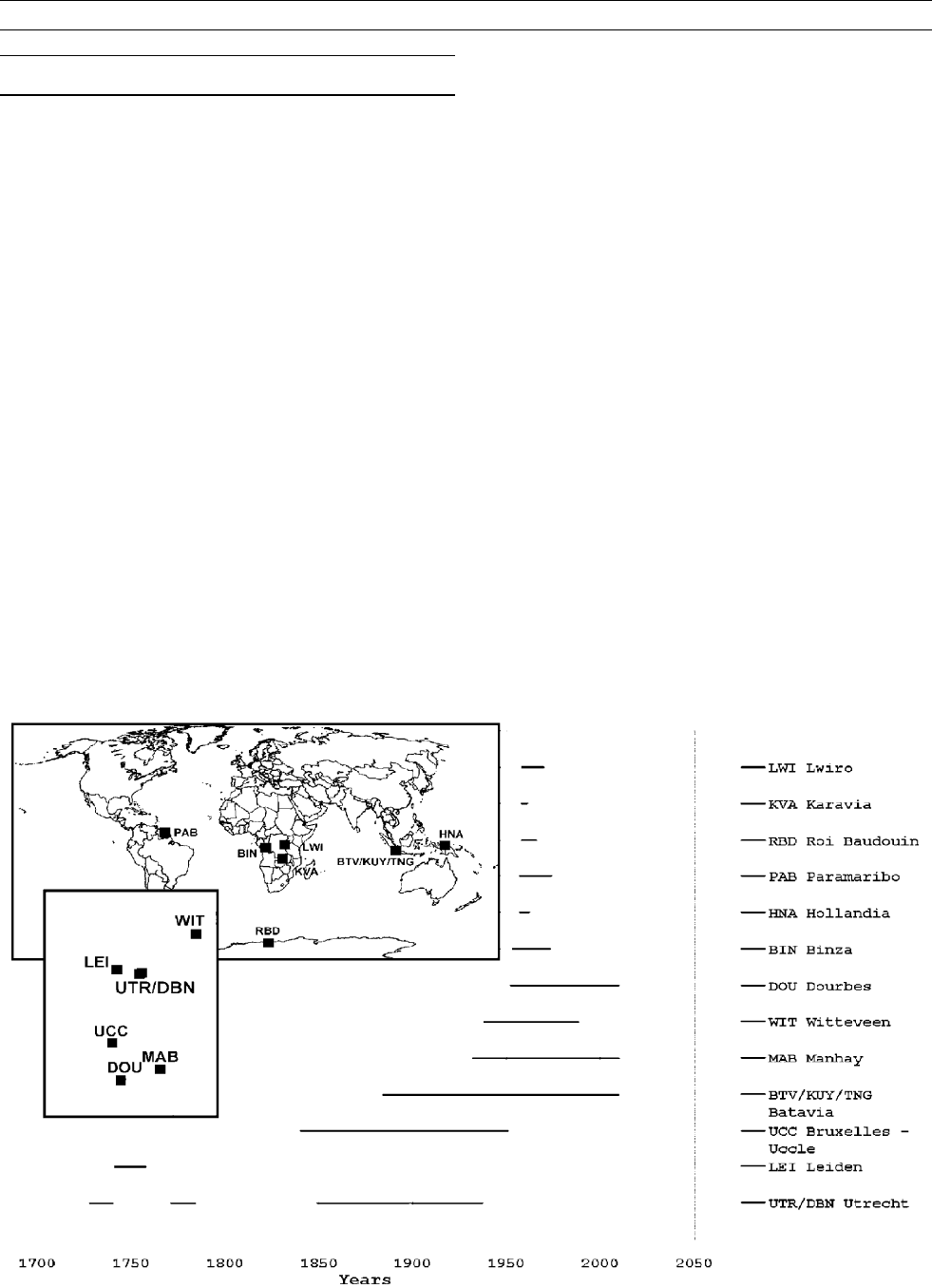
OBSERVATORIES IN BENELUX COUNTRIES
Introduction
Benelux is a small geographical entity, which encompasses the coun-
tries Belgium, the Netherlands, and The Grand Duchy of Luxembourg.
Although the Benelux countries cover a small area, there has been inter-
est there for magnetic observations since early on. As a result, many
observatories have been created by the Benelux countries at home and
abroad. Luxembourg has no observatory of its own, only field geomag-
netic measurements have ever been made (Flick and Stomp, 2002).
Short history
The Dutch scientist Pieter van Musschenbroek was the first to continu-
ously observe the magnetic declination starting 1728 in Utrecht and later
Leiden until 1758. These measurements initiated a long series of obser-
vations in the Netherlands, with additional observatory locations in
De Bilt (1898) and Witteveen (1938). However, in 1988 the manage-
ment of the Dutch Meteorological Institute KNMI decided to stop fund-
ing magnetic observations in the Netherlands. This effectively ended the
260-year data series in the Netherlands (Schreutelkamp, 2001).
It was also the Dutch who decided in 1826 to build a magnetic obser-
vatory in Brussels. This was masterminded by the scientist Adolphe
Quetelet and the institution was created almost at the time of the birth
of the Belgian state. The location of the observatory changed three times
within Brussels, because of the presence of local anomalies. In 1888 the
observatory was located in Uccle at the outskirts of the Belgian capital.
The century long series in Brussels had to be interrupted completely
in 1952 due to cultural noise, while a new observatory was being
constructed in the Namur province. This became the Dourbes (DOU)
magnetic observatory in use today. It joined the INTERMAGNET
consortium in 2002 (see Observatories, INTERMAGNET ).
The University of Liège recorded the geomagnetic field in Cointe
starting 1880, but its first full-size observatory was built in Manhay
(MAB) for the International Polar Year (IPY) of 1932–1933 by Marcel
Dehalu. DOU staff took over MAB operation in 1990.
Worldwide dissemination
The founding of the Dutch Royal Magnetical and Meteorological
Observatory at Batavia, Indonesia, starts the dissemination of world-
wide observatories from the Benelux countries, with the first “exotic”
magnetic data being recorded in 1884. Magnetic observations are still
being made near Jakarta today, although the site of the observatory had
to be moved first to Kuyper and finally to Tangerang to avoid cultural
magnetic noise (see Bemmelen, Willem van).
Binza was installed in Belgian Congo and started delivering data in
1953. Many magnetic observatories were created during the Inter-
national Geophysical Year of 1957–1958: the observatories of Lwiro
and Elizabethville were created by Belgium in Congo as well as the
Base Roi Baudouin (RBD) in Antarctica. The Netherlands installed
Hollandia and Paramaribo in Indonesia and Dutch Guyana, respec-
tively (see Figure O11).
Present situation
From the 14 observatories indicated on Figure O11, only three remain
today: DOU, MAB, both in Belgium, and Tangerang (TNG) in Indo-
nesia. Unfortunately, cultural magnetic noise is on the rise in all of
them, so that short period signals smaller than 1 nT, especially in the
vertical component, are increasingly difficult to study.
Figure O11 Timelines for the life of the observatories in and installed by the Benelux countries. The insert shows their location.
OBSERVATORIES IN BENELUX COUNTRIES 725
